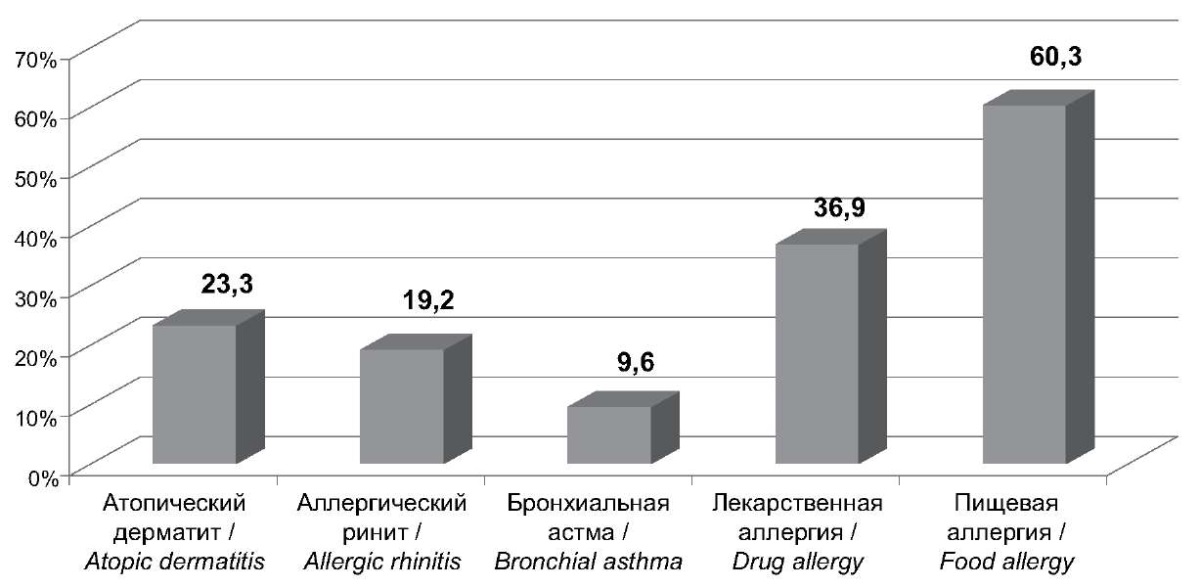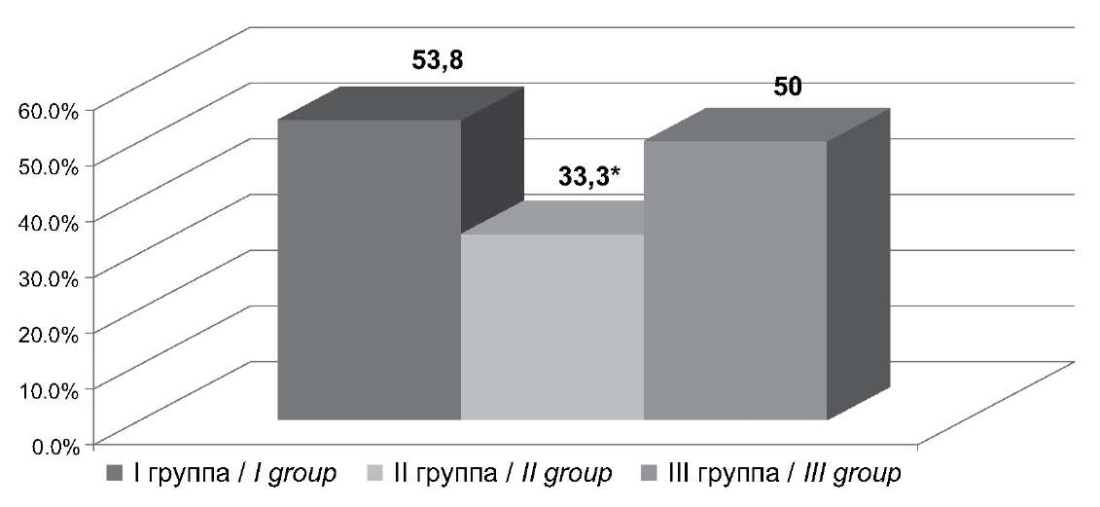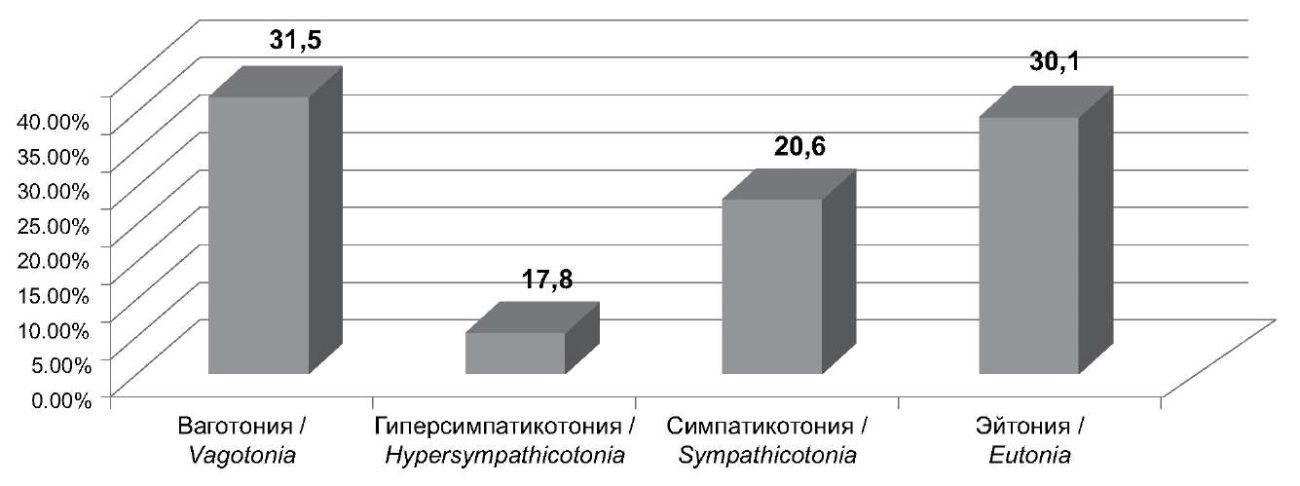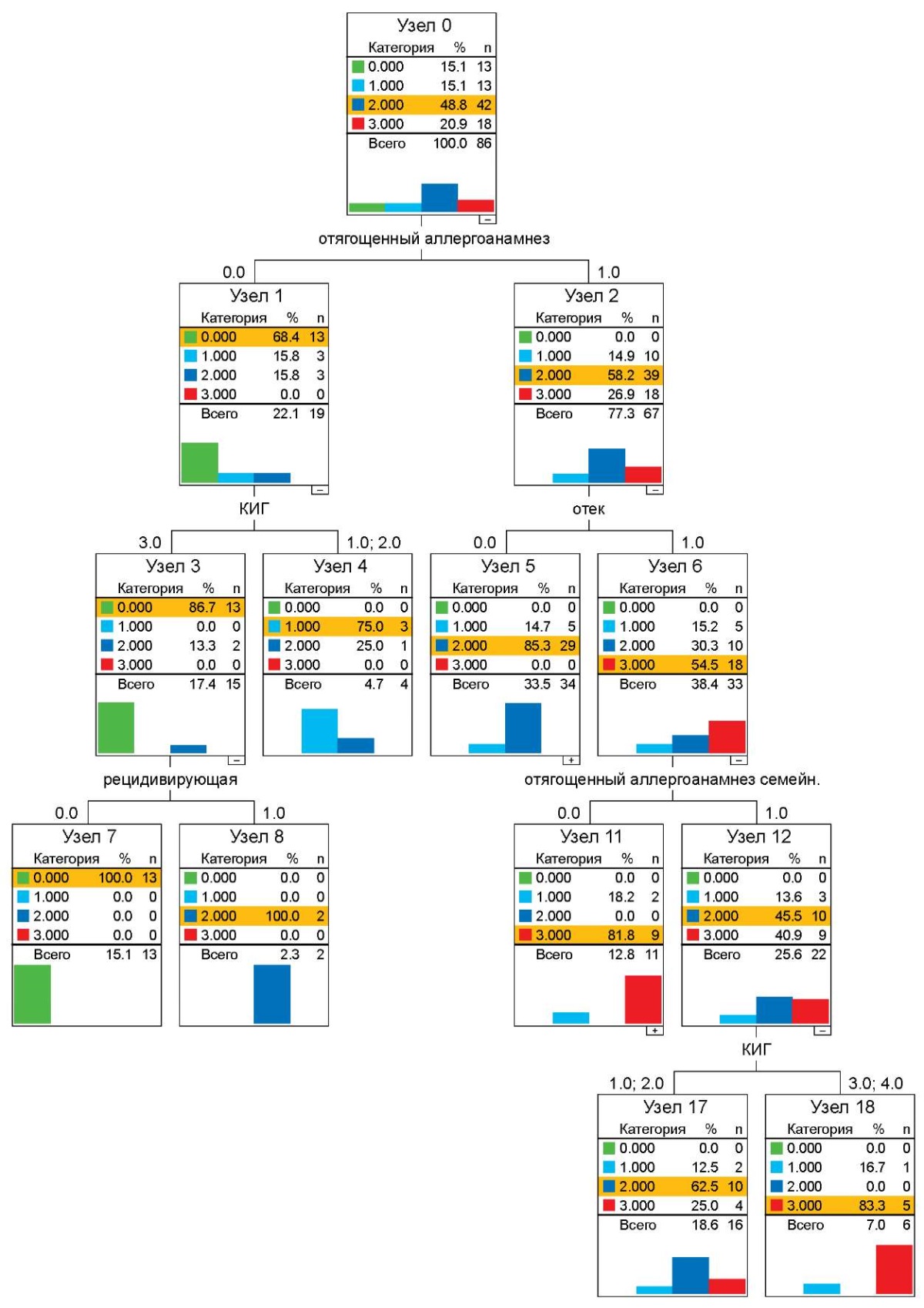Scroll to:
Prediction of the severity of acute urticaria in children, taking into account the type of autonomic dysfunction
https://doi.org/10.21886/2219-8075-2024-15-4-58-65
Abstract
Objective: to study the features of the influence of the autonomic nervous system on the severity of acute urticaria in children.
Materials and methods: 73 children with acute urticaria were examined. Clinical research methods included an analysis of the life history and illness, an objective examination of the child, and recording of a cardiointervalogram.
Results: clinical and anamnestic data made it possible to identify features of the course of the disease that were not previously noted before the development of urticaria, such as complaints of pain in the heart, a feeling of difficulty breathing (without the presence of concomitant quincke's edema), dizziness, increased sweating (mainly of the palms and soles); analysis of the initial autonomic tone in children with acute urticaria; in cases of mild disease, a pronounced predominance of eutonia is observed, which indicates a coordinated increase in the activity of both the sympathetic and parasympathetic parts of the autonomic nervous system, and in patients with a pronounced clinical picture, a noticeable predominance of vagotonia is recorded.
Conclusion: The created model for predicting the severity of acute urticaria, taking into account clinical and anamnestic parameters, as well as changes in the functioning of the autonomic nervous system, makes it possible to more objectively assess the severity of this pathology.
For citations:
Averkina L.A., Posevina A.N., Maltsev S.V., Lebedenko A.A. Prediction of the severity of acute urticaria in children, taking into account the type of autonomic dysfunction. Medical Herald of the South of Russia. 2024;15(4):58-65. (In Russ.) https://doi.org/10.21886/2219-8075-2024-15-4-58-65
Introduction
Acute urticaria is characterized by multiple itchy urticarial rashes arising from various causes1. Due to the increasing prevalence and economic costs caused by the treatment costs and emergency medical care, interest in a better understanding of the pathogenetic mechanisms of this disease is growing.
When considering the features of the acute urticaria clinical course in children, the question of the factors that determine its severity and repeated episodes of occurrence remains unclear. The value of the etiotropic factor as determining the severity of the disease is not confirmed [1]. To date, a number of authors have the opinion that there is a certain "predisposition of the autonomic nervous system", which worsens the course of urticaria, and in this case, the trigger serves only as a catalytic factor that activates this system and leads to the pathophysiological stage of allergic inflammation [2]. Nevertheless, studies regarding the role of autonomic imbalance in the development of acute urticaria are scarce. In this regard, the importance of assessing autonomic indicators in patients with acute urticaria becomes apparent, especially in cases of severe and recurrent episodes, taking into account the initial tone of the autonomic nervous system. This is necessary for a deeper understanding of the disease mechanisms and for adequate correction of complex treatment, taking into account the individual characteristics of the patients.
The purpose of the investigation is to study the features of the autonomic nervous system’s influence on the severity of the acute urticarial course in children.
Materials and methods
Seventy-three children with acute urticaria were examined. The control group consisted of 30 children of health groups I and II, comparable in sex and age (Order of the Ministry of Health of the Russian Federation of December 30. 2003 No. 621 "On a comprehensive assessment of the state of children’s health"). A complete clinical and laboratory examination of patients was carried out on the first day of admission of the child, before the start of therapy in the hospital. The anamnestic criterion for the inclusion of patients in the study was the presence of urticaria episodes lasting no more than 6 weeks [3]. Assessment of the functional state of the autonomic nervous system in children was carried out using spectral analysis of the cardiointervalogram. The recording was carried out on the apparatus "ANKAR-131" (Taganrog, Russia) in the position of a patient lying down for 5 minutes. As descriptive statistics for quantitative indicators, the median and quartiles in the sample were calculated, comparisons of medians in groups were carried out using the Mann-Whitney test, the differences were considered statistically significant at the level of p < 0.05. Statistical analysis and processing of the collected data were performed in R version 3.3, R Foundation for Statistical Computing, Vienna, Austria.
Results
All patients were divided into 3 groups based on the severity of the disease: group I (n = 13) included children with mild urticaria (17.8%), group II (n = 42) included children with moderate urticaria (57.5%), and group III (n = 18) included children with severe urticaria (24.7%).
The severity of the disease was assessed based on the severity of clinical symptoms, the prevalence of skin elements, and the duration of the disease (see Table 1). The use of the UAS7 scale was not possible, since the majority of the examined patients had an episode of acute urticaria lasting less than 7 days.
Таблица / Table 1
Критерии оценки степени тяжести острой крапивницы
Criteria for assessing the severity of acute urticaria
|
Балл Scores |
Волдыри Wheals |
Зуд Pruritus |
Длительность высыпаний (дни) Duration rashes (days) |
|
0 |
Нет/ No |
Нет/ No |
Нет/ No |
|
1 |
Лёгкая (<20 волдырей / 24 ч.) Light (<20 wheals / 24 h.) |
Лёгкая (присутствует, но не причиняет беспокойство) Light (present, but not disturbing) |
< 3 |
|
2 |
Средняя (20 – 50 волдыря / 24 ч.) Average (20 – 50 wheals / 24 h.) |
Средняя (беспокоит, но не влияет на дневную активность и сон) Average (disturbing, but does not affect daytime activity and sleep) |
3 – 5 |
|
3 |
Интенсивная (>50 волдырей / 24 ч. или большие сливающиеся волдыри) Intense (>50 wheals / 24 h. or large merging wheals) |
Интенсивная (тяжёлый зуд, достаточно беспокоящий и нарушающий дневную активность, и сон) Intense (severe itching, quite disturbing and disrupting daytime activity and sleep) |
> 5 |
The severity of the disease was assessed using the sum of the points: mild – < 3; moderate – 4–6; heavy – 7–9.
As a result of the study, it was found that the majority of the examined patients (75.3%, p < 0.05) developed the disease for the first time and were characterized by different prevalence and size of urticarial elements, as well as the intensity of pruritus. Urticaria sizes ranged from 0.5 cm to 17 cm and were located most often on the face (56.1%), on the trunk (43.8%), and on the upper limbs (39.7%). It was revealed that in the overwhelming number of examined children (61.6%), the first rashes appeared mainly in the area of the anterior surface of the body (p = 0.04). When assessing the time of day of acute urticaria, it was found that in most patients the first clinical symptoms occurred at night and in the morning (p < 0.05).
A study of clinical and anamnestic data revealed that the majority of children (91.7%) had concomitant allergic diseases (Fig. 1).

Рисунок 1. Структура сопутствующих атопических заболеваний у детей с острой крапивницей (%)
Figure 1. Structure of concomitant atopic diseases in children with acute urticarial (%)
It is important to note that food allergy was diagnosed in 44 (60.3%) patients, which indicates an immune genesis of the urticaria development. The following products had the greatest allergenic activity for these patients: strawberries, citrus fruits, chocolate, and honey. Besides, 23.3% of children had a history of atopic dermatitis, 19.2% of children – allergic rhinitis, and 9.6% of children – asthma. It should be noted that a third of the examined patients had suffered from drug allergies (36.9%).
It is known that the presence of allergic diseases in the family history can also affect the development of symptoms of this disease [4]. In the studied group of children, 37 (50.7%) patients had a burdened family history of allergies, of which 27.0% were maternal and 16.2% were paternal. It should be noted that on both lines of kinship, atopic diseases occurred in 56.8% of children. When studying the structure of allergopathology among mothers, it was found that allergic rhinitis was significantly more common (45.1%) (Table 2). Bronchial asthma (9.7%), food allergy (19.4%), atopic dermatitis (12.9%), and drug allergy (12.9%) were less common.
Таблица / Table 2
Частота аллергических заболеваний по материнской и отцовской линии родства у детей с крапивницей (%)
Incidence of diseases along monetary and paternal lines of kinship in children with urticaria (%)
|
Заболевание Disease |
По материнской линии Maternal line (n=31) |
По отцовской линии Paternal (n=27) |
|
Бронхиальная астма Bronchial asthma |
39,7% |
7,4% |
|
Аллергический ринит Allergic rhinitis |
45,1%* |
25,9% |
|
Пищевая аллергия Food allergies |
19,4% |
48,2%* |
|
Лекарственная экзантема Drug exanthema |
12,9% |
7,4% |
|
Атопический дерматит Atopic dermatitis |
12,9% |
11,1% |
Примечание: * — р < 0,05.
Note: * — р < 0,05.
Analysis of paternal allergopathology revealed a significant predominance of food sensitization (48.2%) [ p < 0.05]. Allergic rhinitis (25.9%), atopic dermatitis (11.1%), bronchial asthma (7.4%), and drug allergy (7.4%) were less common on the line of father kinship.
Upon admission, all children and/or their parents have reported skin rashes and itching. Besides this, in 30 (41.1%) patients, acute urticaria was accompanied by Quincke's edema. Due to an increase in the permeability of the vessel walls of the mucous, submucous membranes, and skin, the release of fluid into the interstitial space, and massive local edema, this state was life-threatening when localized in the oropharynx and neck. During the analysis, it was found that Quincke's edema developed in 53.8% of cases in children of group I, in a third of the examined patients of group II, and in half of the patients of group III (Fig. 2). Thus, Quincke's edema was least frequently reported in patients with moderate urticaria (p < 0.05). The most common location of edema was the head and neck area (p = 0.03). Also, several patients (5.5%) had swelling of the knee and ankle joints upon admission to the hospital.

Рисунок 2. Частота встречаемости отёка Квинке у детей с различной степенью тяжести течения острой крапивницы (%)
Figure 2. Frequency of occurrence of angioedema in children with varying degrees of severity of acute urticaria (%)
Примечание: * — р < 0,05.
Note: * — р < 0,05.
During the examination of patients, we noticed that besides the main clinical symptoms, 65.7% of patients had other complaints that were not noted before the urticaria development (Fig. 3). In 23 (31.5%) children with acute urticaria, there were complaints of pain in the heart, in 11 (15%) – a feeling of shortness of breath (without the presence of concomitant Quincke edema), in 17 (23.3%) children – dizziness, and in 17.8% of cases, increased sweating (mainly palms and soles) was noted. Irritable bowel syndrome was observed as a manifestation of autonomic nervous system disorder in 7 (14.5%) patients and was characterized by pain in the lower abdomen, flatulence, and urges to defecate.

Рисунок 3. Вегетативные расстройства у детей с острой крапивницей (%)
Figure 3. Autonomic disorders in children with acute urticaria (%)
One of the reliable and at the same time convenient for practical application methods for assessing the state of the autonomic nervous system is the method of variational heart rate. It allows studying the distribution of cardiointervals as random variables in the studied series. For this, we used a special interval graph – a histogram.
The initial vegetative tone in children with acute urticaria was assessed by calculating the stress index during the background test.

Рисунок 4. Исходный вегетативный тонус у детей с острой крапивницей (%)
Figure 4. Initial autonomic tone in children with acute urticaria (%)
It was revealed that vagotonia occurred in the majority of examined children (31.5%), hypersympathicotonia – in 17.8% of cases, eitonia – in 22 (30.1%) patients, and sympathicotonia – in 15 (20.6%) children with acute urticaria.
When comparing the initial vegetative tone in the groups, it was found that children with a mild course of acute urticaria were significantly more likely to have eitonia (76.9%) [ p = 0.02], less often sympathicotonia (15.4%) and vagotonia (7.7%), while hypersympathicotonia was not reported in any patient (Table 3).
Таблица / Table 3
Исходный вегетативный тонус у детей с острой крапивницей различной степени тяжести (%)
Initial autonomic tone in children with acute urticaria of varying severity (%)
|
Ваготония Vagotonia |
Гиперсимпатикотония Hypersympathicotonia |
Симпатикотония Sympathicotonia |
Эйтония Eitonia |
|
|
I группа I group |
7,7 |
0* |
15,4 |
76,9* |
|
II группа II group |
23,8** |
30,9** |
33,3 |
12 |
|
III группа III group |
66,7*** |
0 |
33,3 |
0*** |
Примечание: * — р < 0,05 при сравнении I и II групп; ** — р < 0,05 при сравнении II и III групп, *** — р<0,05 при сравнении I и III групп.
Note: * — p < 0.05 for indicators of groups I and II; ** — p < 0.05 in the analysis of groups II and III, *** — p < 0.05 in the analysis of groups I and III.
It was found that in children of group II, vagotonia was observed in 23.8% of cases, sympathicotonia and hypersympathicotonia occurred in almost the same percentage of cases (30.9% and 33.3%), and normal initial vegetative tone was detected in 5 (12%) examined patients with moderate acute urticaria. It should be noted that hypersympathicotonia was reported only in children of group II (p = 0.01).
Analysis of the distribution of the initial vegetative tone in children with pronounced clinical manifestations, common urticarial rashes on the skin, and intense pruritus revealed the predominance of vagotonia (66.7%) in most patients.
It is important that with increasing severity, there was a significant increase in the frequency of registration of vagotonia in children with acute urticaria (p = 0.03) and a significant decrease in the incidence of eitonia (p = 0.02), which confirms the contribution of the parasympathetic department of the vegetative nervous system as a factor affecting the severity of the disease.
Based on the created Excel database, including all studied parameters of the acute urticaria course features and the vegetative status of the patient, randomization of indicators was carried out depending on the severity of the disease course, assessed on the basis of the severity of clinical symptoms, the prevalence of skin elements, and the duration of the disease. Further, possible predictors of the risk of severe acute urticaria were identified using a comparative analysis of qualitative and quantitative variables by Fisher's test criteria, adjusted for multiple comparisons by Holm and Kraskel-Wallis, respectively.
Then using "Decision trees" multivariate analysis ("Classification and regression trees" CRT method) (Fig. 5), a model was constructed to predict the severity of acute urticaria (dependent variable), while independent variables were a burdened personal allergy, the presence of concomitant Quincke's edema, repeated episodes of urticaria, a burdened family allergy, as well as the cardiointervalography results.

Рисунок 5. Дерево решений расчёта тяжести течения острой крапивницы у детей
Figure 5. Decision tree for calculating the severity of acute urticaria in children
Thus, the multivariate analysis revealed that the probability of developing a mild course of acute urticaria was 75% in the absence of a burdened personal allergic history and in the presence of eitonia or simaticotonia.
It was found that the moderate course of acute urticaria developed in 85.3% of children with acute urticaria, subject to the following conditions: in the presence of a burdened allergic history and in the absence of concomitant Quincke edema.
The presence of a burdened own and family allergic history, concomitant Quincke's edema, as well as vagotonia, as the initial vegetative tone, will lead to the development of a severe course of acute urticaria in 83.3% of cases.
Discussion
Autonomic disorders associated with acute urticaria can manifest themselves through various symptoms, such as sweating, heart palpitations, and changes in the patient's psycho-emotional state [5]. These manifestations not only worsen overall well-being but also contribute to increased itching and rashes, creating a vicious circle that makes treatment difficult.
The investigations show that autonomic regulation can have an impact on inflammatory processes in the skin. Changes in the autonomic nervous system increase the allergic reaction, leading to a more pronounced course of urticaria [6].
In the study, it was revealed that cardialgia and rapid breathing were combined with behavioral disorder, which was manifested by aggression and a sudden attention deficit disorder. Catamnestic data indicate that in almost a third of patients (p = 0.04) these complaints persisted for different periods of time (from 5–7 days to 1–1.5 months). It is important to note that repeated episodes of urticaria are more often noted in such children (p = 0.04). This makes it possible to confirm the hypothesis that autonomic disorders that occur against the background of acute urticaria play a significant role both during the present episode of urticaria and in the development of repeated rashes.
According to Kecheimakina (2022), skin sensitization develops against the background of functional shifts in the central and autonomic nervous systems [5]. Neurovegetative regulation affects the activation of immunocompetent cells and the subsequent phase of the pathological process in allergic diseases [6].
Assessment of the initial vegetative tone in children with acute urticaria revealed the predominance of eitonia in the case of a mild course of the disease. This indicates a simultaneous increase in the activity of both the sympathetic and parasympathetic sections of the autonomic nervous system. At the same time, patients with severe clinical symptoms had a clear dominance of vagotonia. This indicates that the parasympathetic section significantly affects the pathophysiological features of the acute urticaria course, which confirms the current literature [2].
Conclusion
- Most of the examined children (91.7%) had concomitant allergic diseases, such as food allergy (60.3%), atopic dermatitis (23.3%), allergic rhinitis (19.2%), bronchial asthma (9.6%), and drug allergy (36.9%).
- Thirty-seven (50.7%) patients had a family history of allergies, of which 27.0% on the mother's side and 16.2% on the father's side.
- It was revealed that in 30 (41.1%) patients, acute urticaria was accompanied by Quincke's edema, of which in 53.8% of cases in children of group I, in a third of group I, and in half of group III.
- In children with a mild course of acute urticaria, eitonia was significantly more common (76.9%), with a moderate course – sympathicotonia and hypersympathicotonia (in almost the same percentage of cases – 30.9% and 33.3%), with a severe course – vagotonia (66.7%).
- The developed model for predicting the severity of acute urticaria, including clinical and anamnestic features, as well as changes in the autonomic nervous system, makes it possible to more objectively assess the severity of the disease.
1. Клинические рекомендации «Крапивница» – РААКИ, Российское общество дерматовенерологов и косметологов, Союз педиатров России; 2023. 66 с.
References
1. Peck G, Hashim Mj, Shaughnessy C, Muddasani S, Elsayed NA, Fleischer AB jr. Global Epidemiology of Urticaria: Increasing Burden among Children, Females and Low-income Regions. Acta Derm Venereol. 2021;101(4):adv00433. https://doi.org/10.2340/00015555-3796
2. Dzhuraev M.N., Tavakalov M.M. Features of the clinical course of allerhodermatosis in children with vegetative dysfunctions. Bulletin of postgraduate education in the field of healthcare. 2019;(2):15-18. (In Russ.) eLIBRARY ID: 41570798 EDN: LOxTOR
3. Hawro T, Ohanyan T, Schoepke N, Metz M, Peveling-Oberhag A, et al. Comparison and interpretability of the available urticaria activity scores. Allergy. 2018;73(1):251-255. https://doi.org/10.1111/all.13271. Epub 2017 Sep 18. PMID: 28815631.
4. Lepeshkova T.S., Beltyukov E.K., Tsarkova S.A. Food anaphylaxis in children. Allergology and Immunology in Paediatrics. 2020;(1):26-43. (In Russ.) eLIBRARY ID: 42799978 EDN: TCYPNI
5. Kechemaykina M.I., Kiryukhina S.V., Podsevatkin V.G., Shubin D.YU. Psychodermatology: neurodermitis as a psychosomatic pathology. Psychophysiology news. 2022;(2):43-49. (In Russ.) https://doi.org/10.34985/h3007-9835-8299-j
6. Khakimova R.F., Skorokhodkina O.V., Klucharova A.R. Cholinergic urticaria in pediatricians’ practice. Allergology and Immunology in Paediatrics. 2021;(2):31-36. (In Russ.) https://doi.org/10.24412/2500-1175-2021-2-31-36
About the Authors
L. A. AverkinaRussian Federation
Lidiya A. Averkina, assistant of the Department of children's diseases №2
Rostov-on-Don
Competing Interests:
Authors declares no conflict of interest.
A. N. Posevina
Russian Federation
Anastasia N. Posevina, Cand. Sci. (Med.), assistant of the Department of children's diseases №2
Rostov-on-Don
Competing Interests:
Authors declares no conflict of interest.
S. V. Maltsev
Russian Federation
Stanislav V. Maltsev, Cand. Sci. (Med.), associate Professor, head of pediatric Department of clinic
Rostov-on-Don
Competing Interests:
Authors declares no conflict of interest.
A. A. Lebedenko
Russian Federation
Alexander A. Lebedenko, Dr. Sci. (Med.), Professor, head of the Department of children's diseases №2
Rostov-on-Don
Competing Interests:
Authors declares no conflict of interest.
Review
For citations:
Averkina L.A., Posevina A.N., Maltsev S.V., Lebedenko A.A. Prediction of the severity of acute urticaria in children, taking into account the type of autonomic dysfunction. Medical Herald of the South of Russia. 2024;15(4):58-65. (In Russ.) https://doi.org/10.21886/2219-8075-2024-15-4-58-65







































